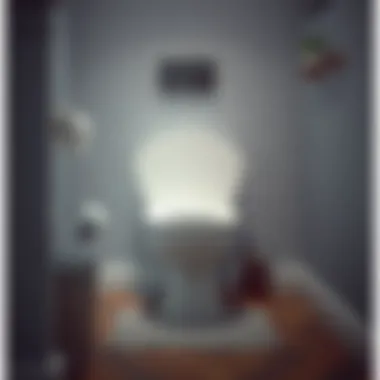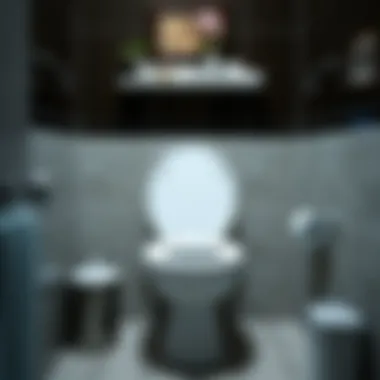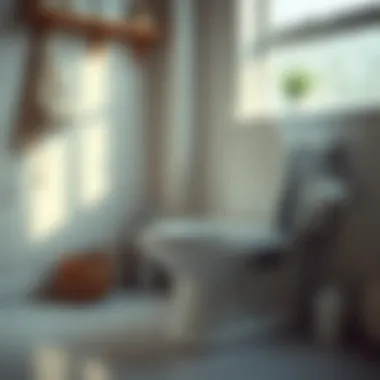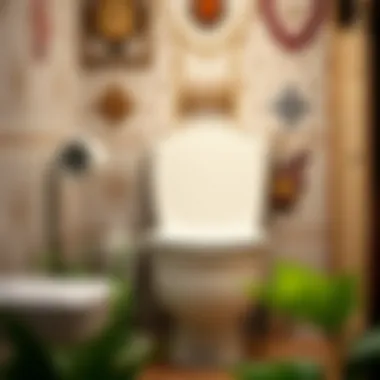Smart Solutions to Unclog a Toilet Without a Plunger


Intro
Dealing with a clogged toilet can send a shiver down anyone's spine. It's one of those situations that can catch you off guard, making you wish you had paid more attention during your plumbing 101 class. More often than not, reaching for a plunger is the immediate reaction. But what if you find yourself without one? It’s crucial to have a backup plan and know how to tackle this situation with poise. This guide dives into effective methods that empower homeowners and renters alike, allowing them to resolve unexpected clogs efficiently without a plunger in sight.
In this article, we will explore several practical tricks and techniques that not only help you clear the blockage but also prevent future mishaps. Equip yourself with knowledge that saves a headache and helps maintain the integrity of your toilet system.
Throughout this journey, you’ll find useful tips, common pitfalls to avoid, and insights that highlight fundamental practices. Let’s roll up our sleeves and get to work.
"A well-maintained toilet is a happy toilet."
After all, preventive care is just as important as quick fixes.
Foreword to Toilet Clogs
Toilet clogs can be a homeowner's worst nightmare. They don’t just disrupt your daily routine; they can lead to costly repairs and irritation for everyone using the facilities. Understanding the ins and outs of toilet clogs is essential in effectively managing and resolving these issues when they arise.
Understanding Common Causes
Toilets can clog for a variety of reasons, and it’s important to know what typically leads to these blockages. One common culprit is excessive toilet paper usage. Many people tend to use more than necessary, which can quickly overwhelm the system, leading to a significant backup. Another reason can be foreign objects—kids sometimes treat toilets like a toy box, and a dropped toy can easily lead to a clog. Additionally, the deterioration of plumbing can contribute to regular backups. Old pipes may develop rust and sediment, making it easier for waste and toilet paper to accumulate and create blockages.
"Understanding the causes of clogs can often save you a headache down the road."
The Importance of Timely Resolution
Taking the necessary steps to address a clog promptly can prevent more severe issues down the line. Ignoring a blockage can result in overflows, which may lead not only to an unsightly mess but also to water damage that can be expensive to fix. Sometimes, what begins as a minor inconvenience can snowball into a much bigger problem if left unattended.
Furthermore, many minor clogs can be resolved without calling a plumber, allowing you as a homeowner to handle the situation with confidence. Getting to the root of the issue quickly can mitigate potential damages to your plumbing system and save you money in repairs or professional assistance. Familiarizing yourself with the common causes of toilets clogs prepares you to tackle these issues head-on without feeling overwhelmed.
Diagnosing the Problem
Diagnosing the problem of a clogged toilet is a crucial step in resolving the issue swiftly and effectively. Recognizing the current state of blockage helps the homeowner or renter determine the right method to fix it, avoiding panic and further complications down the line. If you dive in blind, you may find yourself throwing various solutions at the problem—only to realize none are tackling the root cause. Hence, taking the time to assess the situation is highly beneficial; it keeps frustration at bay.
Understanding the severity of the clog can really set the stage for how you will approach resolving it. For instance, a minor blockage might just need a bit of warmth or detergent, while a more stubborn one may require mechanical intervention with tools like a toilet auger. Knowing what to expect saves both time and effort.
Additionally, being able to identify specific signs of blockage can offer vital clues about what’s causing the issue. By honing in on these details, you may also be able to prevent future clogs from occurring. So, let's break this down further.
Identifying the Severity of the Clog
Identifying the severity of the clog is not merely about gauging how much water is or isn’t draining. It's about paying attention to several indicators that can signal the depth of your trouble. You might find yourself tied up in thoughts like:


- Water level: Is the water level high, close to the brim, or draining slowly? If it’s sitting high, the situation is urgent.
- Multiple fixtures affected: If you flush the toilet and realize the sink drains or tub begins gurgling, you might have a more extensive plumbing issue.
- Timing: When did the clog start? If it comes on suddenly, it might be easier to address. If it’s been creeping up over time, then you probably have a buildup issue.
These signs will guide you to what tools or methods to use, and, ultimately, how much elbow grease you might need to exert.
Signs That Indicate a Blockage
There are several signs that hint you’re dealing with a blockage, and keeping an eye on them can make all the difference. Here are key indicators:
- Gurgling noises: If the toilet or any adjacent plumbing makes strange gurgling sounds, it's a solid indicator of a blockage.
- Slow draining: Water sits in the bowl longer than expected or drains sluggishly? That's a red flag.
- Unpleasant odors: Bad smells wafting from your toilet could be a telltale signal of decay or backup.
- Overflow: The scariest sign—water spilling over the toilet bowl when flushed. If this happens, you are in critical territory.
Recognizing these signals early can help guide your next steps and keep you ahead of a larger mess. Knowing how to diagnose effectively equips you to tackle the problem with confidence. In addition, relying on DIY methods might save you not just a few bucks, but also give you the satisfaction of handling something unexpected. Remember to act cautiously and thoughtfully—your toilet will thank you!
Using Household Items for Unclogging
When faced with a clogged toilet, many people might feel like they’re stuck in a pickle. However, there's a silver lining: often, you can resolve the issue without the need for a plunger. Using household items not only reinvigorates commonly used solutions but also saves you time and money. From savvy use of basic kitchen supplies to leveraging the properties of everyday liquids, unblocking a toilet can be a straightforward task.
Hot Water Technique
One of the simplest methods to resolve a clogged toilet involves hot water. You don’t need to boil a cauldron for this; hot tap water does the trick more often than not. The trick here is to pour the hot water from a height, which increases the impact and can help dislodge the blockage.
Here’s how to do it:
- Boil some water in the kettle or bring a pot of water to a simmer. Avoid boiling water from the tap; it might not be hot enough.
- Let the water cool down slightly to around boiling point but not too hot that it could crack your porcelain toilet.
- Pour the water directly into the toilet bowl from waist height. The force can help break apart clogs created by waste or toilet paper.
Baking Soda and Vinegar Method
The combination of baking soda and vinegar is renowned for its unclogging prowess. This duo creates a fizzing reaction capable of breaking down clogs. It’s almost like a mini chemical reaction that clears your pipes!
Here’s the step-by-step:
- Add about one cup of baking soda into the toilet bowl.
- Follow it up with two cups of vinegar. You should see it fizz, which is a great sign that things are working.
- Let it sit for at least 30 minutes, allowing the mixture to work its magic. You can also cover the toilet with a towel to keep that heat in.
- Flush the toilet afterwards. Most blockages should clear up with this method.
This method is economical and eco-friendly, eliminating the need for harsh chemicals that can harm your plumbing system or the environment.
Dish Soap Solution
If you have dish soap around, you’re in luck. Dish soap is formulated to break down grease and grime, and it can work wonders when it comes to loosening clogs in your toilet.
Steps to follow:


- Pour a generous dollop (about half a cup) of dish soap into the bowl. Use a soap that’s a bit thicker if possible.
- Let it sit for about 10-15 minutes. This waiting period allows the soap to penetrate the clog.
- Add a couple of cups of hot water to aid in breaking down any obstructions. The combination of soap and hot water helps ensure that waste is loosened up.
- Finally, flush the toilet. If all goes well, the clog should give way, allowing smooth passage for waste once again.
Remember, sometimes persistence pays off. If one method doesn’t work immediately, you might need to try another method or repeat the process. Using household items to unclog a toilet not only serves as a practical solution but also gives you reassurance and confidence in managing common household issues.
Mechanical Methods to Unclog
When faced with a stubborn toilet clog, mechanical methods can offer a more hands-on approach to resolving the issue. These techniques often provide immediate relief when household remedies fall short. Leveraging tools such as a wire coat hanger or a toilet auger can seem daunting, but they are effective solutions worth exploring for any homeowner.
The beauty of mechanical methods lies in their direct intervention. They tackle the blockage head-on, rather than relying solely on chemical reactions or fluids to dissolve the problem. This means faster results and a clear path to restoring your toilet's function. However, there are considerations to keep in mind: using tools incorrectly may cause more harm than good. Below, we will detail two primary mechanical approaches that individuals can utilize to resolve a toilet clog effectively.
Using a Wire Coat Hanger
A wire coat hanger can be a surprisingly versatile tool for tackling those unexpected toilet clogs. When you don’t have a plunger handy, bending that polished metal into a curve can be your knight in shining armor. To start, you will need to unwind the coat hanger until it’s mostly straight, with a small hook at one end.
- Preparation: Begin by putting on some rubber gloves. You want to maintain hygiene, especially when dealing with toilet clogs. Knowing you've got that coverage gives you peace of mind.
- Insertion: Insert the hooked end of the hanger into the toilet bowl, being careful not to scratch the porcelain. Gently agitate the blockage, twisting and turning the hanger. You might feel resistance, so keep at it until you sense it's loosening.
- Removal: If you feel that you’ve managed to break up the clog, pull the hanger out slowly to avoid pushing debris further into the drain. Be prepared for what comes out; it might not be pretty.
This technique not only allows for a physical approach to dislodge hardened clogs, but it also reinforces the notion of using everyday items to solve plumbing problems. Remember, even a simple wire coat hanger can become a gadget of sorts when faced with household nuisances.
Employing a Toilet Auger
When the coat hanger cannot cut it, it’s time to bring in the big guns with a toilet auger—a specialized plumbing tool designed specifically for tackling tough clogs. Using a toilet auger will likely feel more intuitive if you are already accustomed to using tools, but it’s still user-friendly for the average person. Here’s how to make the most out of it:
- Selecting the Right Auger: Before you start, ensure that your toilet auger is the right type. A standard auger has a flexible cable and a corkscrew-like end that grabs onto the obstruction.
- Using the Auger: Insert the end of the auger into the toilet bowl and push through the water until it meets the blockage. Twist the handle to advance the cable deeper into the drain, allowing the auger to snag the clog.
- Clearing the Blockage: Once you feel a stop, rotate the auger to penetrate the obstruction. After a few seconds, pull back gently. If you feel less resistance, you may have successfully cleared the path.
- Flush the Toilet: After using the auger, try flushing the toilet again. If water flows freely, you’ve done your job!
Using a toilet auger may require somewhat of an initial investment, but it is a worthwhile tool for addressing recurring clogs.
Overall, both mechanical methods can significantly reduce the time and frustration involved in unclogging a toilet without relying on a plunger. With just a coat hanger or a dedicated auger, you have the power to tackle those pesky clogs, making your home just a little bit more functional again.
Maintaining Your Toilet to Prevent Future Clogs
Preventing future clogs goes beyond merely handling them when they occur. A well-maintained toilet is central to a home's plumbing system and can save you from the nasty surprises of a blocked toilet down the line. Understanding how to keep your toilet in peak condition not only improves its functionality but also extends its lifespan. The significance of proactive maintenance is rooted in the ability to identify warning signs, adopt best practices, and foster responsible habits within your household.
Regular Cleaning and Maintenance
Cleanliness plays a critical role in preventing clogs. Regular cleaning provides a dual benefit; it removes buildup, like mineral deposits and grime, and allows you to inspect for potential issues. You don’t need to go overboard with harsh chemicals, but a simple weekly routine can work wonders.
- Start with a gentle toilet cleaner that won’t harm your plumbing.
- Scrub under the rim and ensure that you thoroughly clean the bowl to flush away any debris.
- Check for any leaks or wear on the flushing mechanism while you’re at it.
Additionally, you might think about the water quality in your area. Hard water can cause mineral deposits to form, leading to blockages over time. Using a water softener can help reduce buildup and help you avoid unnecessary headaches.


Keeping the toilet clean not only makes it look nice but also helps keep it working smoothly.
Educating Household Members
Having a well-informed household is paramount in maintaining a functional toilet. Everyone plays a part in reducing the risk of clogs. Discussing proper usage habits can go a long way. Educate every family member about the ramifications of flushing inappropriate items.
- Emphasize the importance of flushing only waste and toilet paper. Other items, such as wipes (even those labeled as flushable), and feminine hygiene products should always go in the trash.
- Teach children the consequences of excessive toilet paper use. A little guidance on the appropriate amount can prevent future headaches.
- Create a system for reporting issues. If someone notices a slow drainage or other irregularity, they should report it. Prompt communication can help nip potential problems in the bud, ensuring the toilet remains functional.
By instilling responsible habits and sharing knowledge, you not only enhance your toilet’s efficiency but also promote a cooperative atmosphere in your home. Keeping things running smoothly is a team effort.
When to Call in a Professional
Dealing with a clogged toilet can feel like a nightmare. While many methods exist to resolve this pesky issue without using a plunger, some clogs are a bit more stubborn or complex. Knowing when to call in a professional can save you from head-scratching frustrations and potential water damage.
Why call a professional? It’s all about understanding your limits and when a simple DIY fix just won’t cut it. Professional plumbers bring a wealth of experience and specialized tools to tackle plumbing problems that may be beyond the average homeowner’s capability. Here are some crucial considerations for when to seek their expertise.
Indicators for Professional Help
Not all clogs respond to home remedies or mechanical methods. Here are some indicators that it's time to dial up a plumber:
- Persistent Blockages: If the clog keeps coming back after multiple attempts to clear it with household methods, it might signal a more severe underlying issue.
- Sewage Backup: Unpleasant odors or signs of sewage backups in other drains or the yard point to serious problems that only a professional can address.
- Water Damage: Any leak around the toilet or signs of moisture in surrounding areas can indicate issues that might worsen without immediate assistance. Ignoring this could lead to extensive repairs in the future.
- Old Plumbing Systems: Bathrooms with older plumbing might have specific design flaws or buildup that requires expert attention.
Remember: If you’re unsure, it’s always better to err on the side of caution and consult a professional. Trying to fix a severe problem without the right knowledge or tools can make things worse and cost you more in the long run.
Choosing the Right Plumber
Once you've decided to get professional help, the next step is to find the right plumber for the job. Here are some essential tips to ensure you make a wise choice:
- Check Credentials: Ensure the plumber is licensed and insured. This protects you from any liability that could arise during the repair process.
- Seek Recommendations: Ask friends, family, or neighbors for recommendations. Often, personal experiences can lead you to trustworthy professionals.
- Read Reviews: Look at online reviews and testimonials. Websites like yelp.com can offer insights into previous customers' satisfaction.
- Get Multiple Quotes: Don't settle for the first quote you receive. Getting a few estimates can help you understand the going rate and gauge the plumbers' reliability.
- Ask Questions: Inquire about their experience with similar issues. This can often reveal how well they understand potential challenges you might face.
Epilogue: Empowering Yourself Against Toilet Clogs
In summary, understanding how to unclog a toilet without a plunger equips homeowners and renters alike with vital skills to deal with one of life’s more unpleasant surprises. We often tend to overlook the minor hiccups in home maintenance, yet when they arise, knowing how to tackle them efficiently can save time, money, and a fair bit of stress.
Recap of Effective Methods
Throughout this article, we've explored several ingenious techniques, ranging from the hot water method to mechanical solutions like a toilet auger. Each method has its own merits:
- Hot Water Technique: This simple strategy can soothe a stubborn blockage, especially when combined with dish soap, to help lubricate and break down the clog.
- Baking Soda and Vinegar Method: A natural remedy that can work wonders; however, timing is essential for effective chemical reactions.
- Dish Soap Solution: Effective in softening obstructions, dish soap is a household staple that should not be underestimated.
- Mechanical Methods: For the more persistent clogs, tools like a wire coat hanger or toilet auger can reach places that DIY methods may not.
Final Thoughts on Preventative Measures
Preventing future plugs is almost as important as addressing the immediate issues. Regular maintenance is paramount. Consider scheduling monthly checks where you:
- Flush without incident to confirm everything works.
- Educate everyone in the household about toilet etiquette—flushing only human waste and toilet paper can significantly minimize clogs.
- Keep an inventory of items that shouldn’t go down the drain. Your toilet isn’t a trash can.
Taking proactive steps doesn’t just alleviate frustration; it saves you from potential plumbing disasters down the line. Recalibrating how we use our toilets and committing to routine checks fosters a more resilient home environment.
In the end, the power to resolve such household issues relays not just on tools, but on knowledge and prevention. Equip yourself with the right methods, and you’ll be ready to face toilet clogs head-on.







